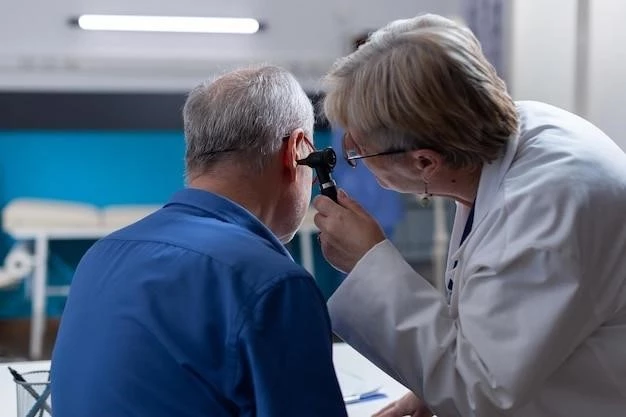Article Plan⁚ Disease⁚ Otofaciocervical Syndrome
Introduction to Otofaciocervical Syndrome
Introduction to Otofaciocervical Syndrome (OTFCS)⁚ Otofaciocervical syndrome is a rare genetic disorder characterized by distinct facial features like a long triangular face, broad forehead, narrow nose and mandible, and a high-arched palate. Individuals with OTFCS may also exhibit dysmorphic ears, a long neck, hearing loss, and skeletal anomalies like low-set clavicles and sloping shoulders. This syndrome has both autosomal recessive and autosomal dominant patterns of inheritance, usually caused by mutations in the PAX1 or EYA1 genes. Further studies have identified additional clinical features such as preauricular or branchial fistulas and cysts, as well as mild intellectual disabilities. The rarity and complexity of OTFCS make it an intriguing area of study for geneticists and healthcare professionals worldwide.
Characteristics of Otofaciocervical Syndrome
Otofaciocervical Syndrome is characterized by facial dysmorphisms such as a long triangular face, prominent and dysmorphic ears, a narrow nose, mandible, and high-arched palate, along with additional features like a long neck and skeletal anomalies. Common signs include low-set cup-shaped ears, preauricular sinus or cyst, hearing loss, branchial and skeletal abnormalities like low-set clavicles, sloping shoulders, and winged scapulae. Individuals may also experience mild intellectual disabilities, making the syndrome complex and intriguing for researchers and healthcare providers.
Genetic Basis of Otofaciocervical Syndrome

Otofaciocervical Syndrome is a rare genetic disorder with patterns of inheritance including autosomal recessive and autosomal dominant. It is primarily caused by mutations in genes like PAX1 and EYA1. Individuals with OTFCS may exhibit a combination of facial dysmorphisms, hearing loss, and skeletal anomalies due to these genetic mutations. Research indicates that both hereditary and random genetic mutations can lead to the onset of this complex syndrome, highlighting the importance of understanding the genetic basis for effective diagnosis and treatment.
Clinical Features of Otofaciocervical Syndrome
Otofaciocervical Syndrome (OTFCS) presents a complex array of clinical features including distinct facial dysmorphisms characterized by a long triangular face, prominent and dysmorphic ears, narrow nose and mandible, and a high-arched palate. Common signs also include preauricular anomalies, hearing loss, branchial defects, and skeletal abnormalities such as low-set clavicles, winged scapulae, and sloping shoulders. Additionally, individuals with OTFCS may exhibit mild intellectual disabilities. The clinical manifestations of OTFCS vary, making this syndrome challenging to diagnose and manage effectively.
Diagnosis of Otofaciocervical Syndrome
Diagnosis of Otofaciocervical Syndrome involves a comprehensive evaluation of the patient’s clinical features, genetic testing to identify mutations in genes like PAX1 and EYA1, and imaging studies to assess skeletal anomalies such as low-set clavicles and winged scapulae. Clinical manifestations, including facial dysmorphisms, hearing loss, and skeletal abnormalities, play a crucial role in diagnosing this rare genetic disorder. Additionally, individuals may undergo auditory testing, imaging of the ear structures, and assessments for intellectual disabilities to confirm the presence of OTFCS.
Treatment Options for Otofaciocervical Syndrome
Management of Otofaciocervical Syndrome focuses on addressing individual symptoms and complications. Treatment may involve a multidisciplinary approach, including hearing aids for hearing loss, surgical correction for skeletal anomalies like low-set clavicles or winged scapulae, and interventions for intellectual disabilities if present. Patients with OTFCS may benefit from early intervention programs, speech therapy, and educational support tailored to their needs. Regular monitoring by medical professionals and genetic counseling for families are vital components of managing this complex genetic disorder.
Prognosis and Complications of Otofaciocervical Syndrome
Otofaciocervical Syndrome prognosis varies based on the severity of symptoms and complications. Individuals with OTFCS may face challenges related to facial dysmorphisms, hearing loss, skeletal anomalies, and intellectual disabilities. Complications may include recurrent infections, particularly among those with immune system deficiencies. Early detection, appropriate management, and regular follow-up care are essential for improving outcomes and addressing potential complications associated with this rare genetic disorder. Research into novel treatment approaches and support services can further enhance the prognosis for individuals with Otofaciocervical Syndrome.
Research and Studies on Otofaciocervical Syndrome
Otofaciocervical Syndrome (OTFCS) has been the subject of extensive research and studies aimed at understanding its genetic basis, clinical manifestations, and associated complications. Genetic studies have identified mutations in genes like PAX1 and EYA1 as key factors in the development of this syndrome. Research has also explored the clinical features of OTFCS, including facial dysmorphisms, hearing loss, skeletal anomalies, and intellectual disabilities, shedding light on the complexity of this rare disorder. Studies have delved into the varied presentations of OTFCS, highlighting the need for personalized treatment approaches for affected individuals.
Case Studies and Patient Experiences
Several case studies have shed light on the varied clinical presentations and experiences of individuals with Otofaciocervical Syndrome. These studies have highlighted common features such as facial dysmorphisms, cup-shaped low-set ears, hearing loss, skeletal abnormalities, and intellectual disabilities. Patient experiences have emphasized the challenges faced by those living with this rare genetic disorder, including the need for multidisciplinary care, early interventions, and ongoing support. Understanding these individual cases contributes to the broader knowledge of Otofaciocervical Syndrome and informs personalized approaches to management and care.
Otofaciocervical Syndrome Type 2 (OTFCS2)
Otofaciocervical Syndrome Type 2, known as OTFCS2, is a rare genetic disorder characterized by facial anomalies, cup-shaped low-set ears, preauricular fistulas, hearing loss, branchial defects, skeletal anomalies like vertebral defects, low-set clavicles, winged scapulae, and sloping shoulders. This condition can also be associated with mild intellectual disability. OTFCS2 patients may exhibit altered thymus development leading to T-cell immunodeficiency and the potential for recurrent or severe infections. Genetic studies have identified mutations in genes like PAX1 contributing to this specific type of Otofaciocervical Syndrome. Management for OTFCS2 may require a multidisciplinary approach to address the diverse array of symptoms and complications associated with this condition.
OTFCS2⁚ Clinical Features and Genetic Mutations
Otofaciocervical Syndrome Type 2 (OTFCS2) presents with distinct clinical features٫ including facial anomalies٫ cup-shaped low-set ears٫ preauricular fistulas٫ hearing loss٫ skeletal abnormalities like vertebral defects٫ low-set clavicles٫ winged scapulae٫ and sloping shoulders. Patients with OTFCS2 may also exhibit mild intellectual disability. The genetic basis of OTFCS2 involves mutations in genes such as PAX1٫ leading to this specific type of Otofaciocervical Syndrome. Additionally٫ individuals with OTFCS2 can experience thymic abnormalities resulting in T-cell immunodeficiency٫ predisposing them to recurrent or severe infections. Understanding the clinical and genetic aspects of OTFCS2 is crucial for diagnosis٫ management٫ and providing appropriate care for affected individuals.

Thymic Abnormalities in Otofaciocervical Syndrome
Otofaciocervical Syndrome may be associated with thymic abnormalities, particularly in cases of Otofaciocervical Syndrome Type 2 (OTFCS2) where altered thymus development can lead to T-cell immunodeficiency. Patients with thymic abnormalities may be predisposed to recurrent or severe infections due to compromised immune function. Thymic abnormalities in OTFCS2 highlight the importance of thorough immunological assessments and monitoring for individuals affected by this specific subtype of Otofaciocervical Syndrome. Understanding the relationship between thymic function and immune health is crucial for managing complications associated with OTFCS2.
Differential Diagnoses for Otofaciocervical Syndrome
When diagnosing Otofaciocervical Syndrome, healthcare providers must consider differential diagnoses to ensure accurate identification and appropriate management. Conditions that may present similarly to OTFCS include 22q11.2 deletion syndrome (DiGeorge syndrome), CHARGE syndrome, and Nude/SCID. Additionally, thymic hypoplasia/aplasia, found in OTFCS2, can also be observed in other clinical conditions, indicating the importance of comprehensive evaluations and genetic testing to differentiate between these disorders. Understanding the differential diagnoses for Otofaciocervical Syndrome contributes to effective treatment strategies and overall patient care.
Support Resources for Individuals with Otofaciocervical Syndrome
For individuals with Otofaciocervical Syndrome, accessing support resources can play a crucial role in managing the challenges of this rare genetic disorder. Support groups and online communities provide a platform for individuals and families to connect, share experiences, and gain valuable information. Healthcare providers specializing in genetic disorders can offer tailored care plans and guidance for those affected by Otofaciocervical Syndrome. Additionally, financial resources, research organizations, and educational materials contribute to enhancing awareness and support for individuals living with this complex condition.
Conclusion and Future Directions in Otofaciocervical Syndrome Research
In conclusion, Otofaciocervical Syndrome remains a complex and rare genetic disorder characterized by distinct facial features, hearing loss, skeletal anomalies, and potential intellectual disabilities. The identification of genetic mutations, particularly in genes like PAX1 and EYA1٫ has advanced our understanding of the underlying mechanisms contributing to this syndrome. Moving forward٫ future research directions in Otofaciocervical Syndrome should focus on exploring personalized treatment options٫ enhancing genetic counseling services٫ and investigating novel therapeutic interventions to improve patient outcomes. Collaborative efforts among researchers٫ healthcare providers٫ and affected individuals will be essential in guiding the future of Otofaciocervical Syndrome research٫ with the ultimate goal of enhancing diagnostic accuracy٫ treatment efficacy٫ and quality of life for those living with this rare condition.
